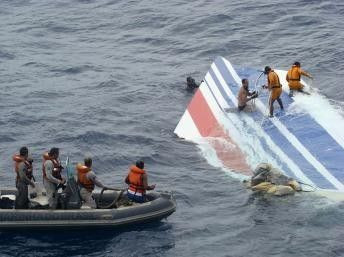Air France Flight 447: Final Report On Crash Released, Better Pilot Training Needed

Information about the crucial last minutes of the Air France flight that crashed into the Atlantic in 2009 has finally been released. In a press conference on Thursday, officials from the Bureau d'Enquêtes et d'Analyses, or BEA -- France's Air Accident Safety Bureau -- pointed to a combination of under-trained pilots and faulty equipment.
It was May 31, 2009, when 216 passengers and 12 crew members boarded the Airbus 330 on a balmy evening in Rio de Janeiro. They were en route to Paris for a scheduled 9 a.m. landing at the Charles de Gaulle airport, but something went wrong in the middle of the Atlantic Ocean during the still-dark early morning hours.
Upon encountering an area of turbulence between South America and Africa, the plane veered left of its flight path. Then it rolled back around to the right. For a couple of minutes, the plane increased its altitude at an unsustainable rate, but the conversations in the cockpit remained calm, and the passengers were not alerted to any danger.
Then, for reasons still hazy to investigators, Flight 447 descended into the ocean. All 228 on board lost their lives.
BEA Chief Investigator Alain Bouillard told journalists on Thursday that an unlikely chain of events during the flight amounted to an insurmountable challenge for the pilot and two co-pilots. He told family members of those who had perished that it would have taken an extremely highly trained flight professional to maneuver out of the situation safely.
The crew was in a state of almost total loss of control of the situation, he said, explaining that they were unaware of their level of risk until it was far too late.
In technical terms, Flight 447 was felled by an increasing angle of attack that reduced the lift coefficient, generating a stall that was not addressed in a timely manner. This means that pilots angled the plane too sharply -- nose up, tail down -- eventually reaching such a tilt that air flow patterns around the wings were altered. This decreased the under-wing air pressure that planes rely on to stay aloft -- a situation referred to as a stall.
Unlike automobile stalls, aircraft stalls have everything to do with aerodynamics and nothing to do with engine functionality. Stalls range in severity according to the angle of tilt; a slight one is easy to for a well-trained pilot to rectify by aiming the nose downward to regain airspeed, and therefore lift, in time to prevent rapid descent.
The question in the case of Air France Flight 447: Why did the pilots continue to pull the nose upward? Such action is the exact opposite of protocol for addressing a stall.
Last year, investigators came closer to finding answers. The plane's black box, which had recorded cabin activity up until the last few minutes of the flight, was found in July 2011 after a lengthy and expensive search.
The recordings revealed that just before turbulence began, the captain -- Marc Dubois, a 58-year-old Air France veteran with 11,000 flight hours -- took a routine short break, leaving two co-pilots to manage the craft. The plane was in its fatal descent by the time he returned to the flight deck, though no one seemed to know it yet.
At the controls at the time was the youngest member of the flight crew, 32-year-old Pierre-Cedric Bonin, aided by the other first officer, David Robert, 37.
The black box also showed that the plane's speed sensors were malfunctioning due to ice crystals obstructing them and that the autopilot disengaged following stall warnings.
The pilots were accustomed to using an autopilot system during cruise and may have been out of their element when forced to fly manually in situations other than takeoff and landing. They were poorly trained for emergency situations at high altitudes and did not seem to realize that the plane was stalling until it was too late.
Investigations into human error will continue even after Thursday's report, so anyone looking to cast blame may still have to wait for quite a while.
Since the accident, Air France has updated its speed sensor equipment and will now implement more thorough manual flight training for pilots.
© Copyright IBTimes 2024. All rights reserved.






















